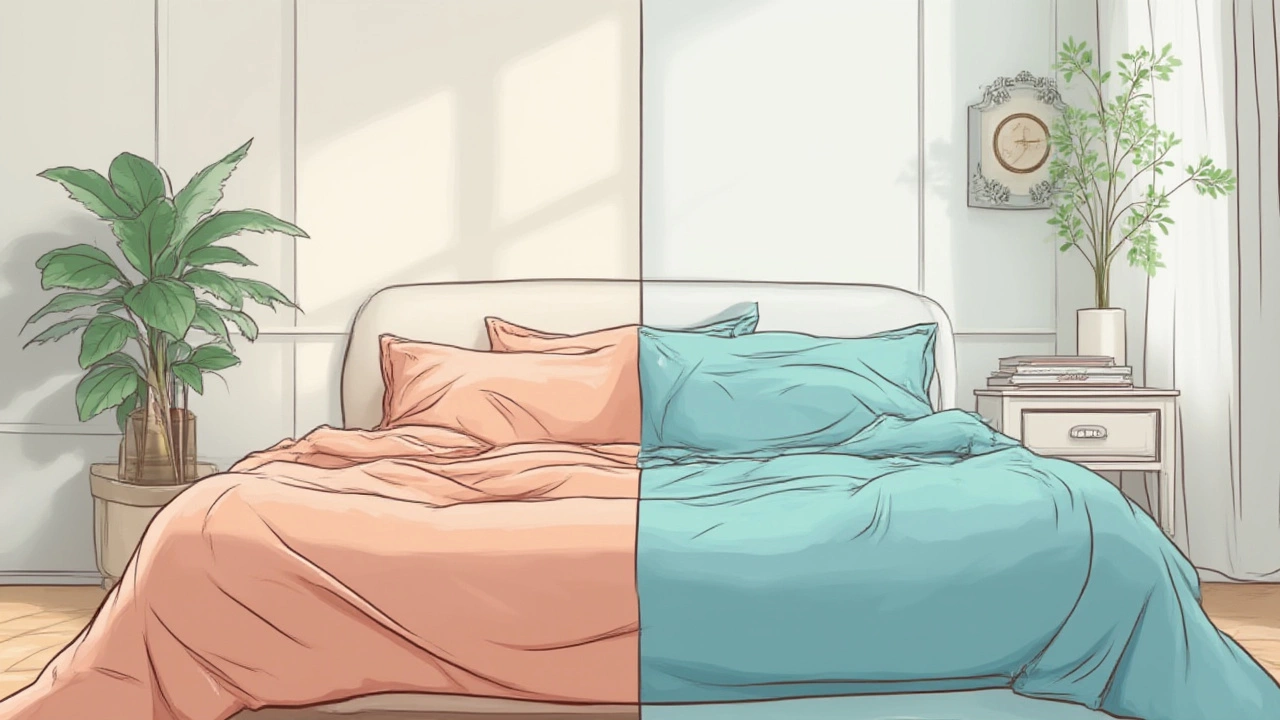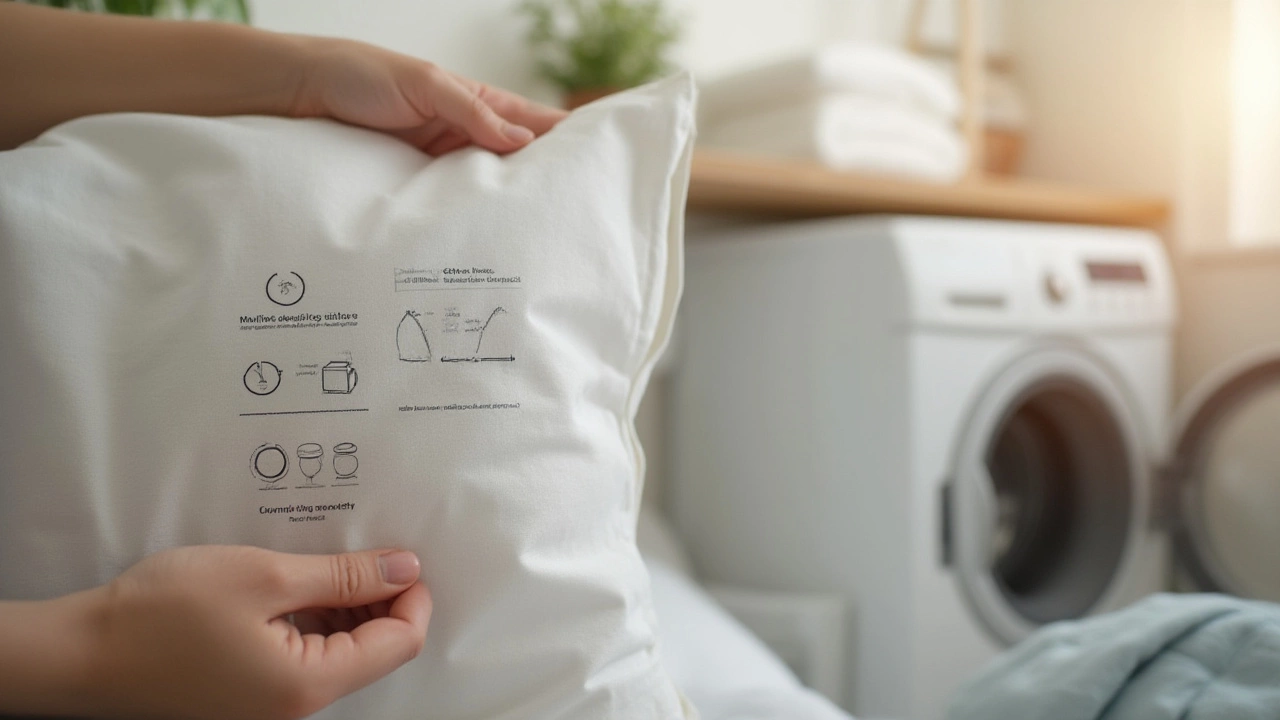How Often Should You Replace Your Bedding? Expert Guide to Clean, Cozy Sleep
 Jul, 12 2025
Jul, 12 2025
You ever wake up feeling groggy, even after a full night’s sleep? Your bedding might be the culprit, hosting everything from sweat to dust mites. The truth is, most people hold onto their sheets and pillows way longer than they should. When it comes to swapping out bedding, there’s a sweet spot between being wasteful and piling up stuff that honestly belongs in the bin. Let’s get real—those crumpled pillowcases and threadbare sheets might be affecting more than your Instagram-worthy bedroom setup.
Why Bedding Replacement Matters
If you’re thinking clean bedding just looks good, there’s a bigger story. Every night, your skin sheds millions of microscopic flakes. These flakes become a feast for dust mites. Add sweat, body oils, and even traces of drool, and your bedding quickly turns into a hotspot for bacteria. And get this—some studies show the average pillow doubles in weight over several years due to a buildup of dust mites and skin. Gross, right?
Dirty bedding doesn’t just make you cringe—it can mess with allergy symptoms, skin health, and even your sleep quality. Ever wonder why your face breaks out, or those sniffles won’t quit at night? Dirty pillowcases and comforters can stir up eczema, acne, and those pesky allergic reactions. If you have asthma or other respiratory issues, shoddy old bedding may stir up nightly trouble. According to the American Academy of Dermatology, laundry day is about more than fresh scents—it’s a simple way to keep your skin and health in top shape.
Even if you’re not a germaphobe, think about comfort: cushions, duvets, and sheets lose structure, becoming lumpy and sad over time. Once your pillow doesn't bounce back when you fold it in half, or your sheets start pilling, it's comfort and support out the window. The National Sleep Foundation reveals that a cozy, clean bed can actually help you fall asleep faster and enjoy deeper sleep cycles. Who doesn’t want that?
Here’s a fact you might like—NASA did a study on how beds affect sleep for astronauts. Their findings? A clean, comfy surface with the right amount of support (think: refreshed pillows and set-in-place sheets) goes a long way, even in zero gravity. You might not be heading to space, but that goes double back here on Earth.
So, yes, keeping tabs on your bedding isn’t just house pride—it's about health, comfort, and better rest every night.
How Often Should You Change Each Part of Your Bedding?
It’s tempting to just wash what looks dirty, but keeping a rotation based on science—not just visible grime—gets you better sleep and a fresher feel. Let’s break down what to swap and when:
- Sheets (fitted and flat): Aim to replace every 2-3 years. Wash them every 1-2 weeks. Articles in the Journal of Environmental Health say that even the best sheets wear out after a few hundred washes, losing softness and becoming more likely to harbor dirt.
- Pillowcases: These handle all your face oils, so change them every 1-2 years, washing weekly. If you're big on skincare, swap your pillowcase twice a week.
- Duvet covers: Wash every 1-2 weeks and replace every 5 years.
- Pillows: The National Sleep Foundation sets the mark: replace them every 1-2 years. They lose support and become dust-mite havens over time.
- Comforters and duvets: These usually last longer—think 10-15 years if you keep them covered and wash twice a year. But if they turn lumpy or lose warmth, it’s time to toss.
- Mattress protectors: Swap these out about every 2 years, especially if you spill anything or sweat a lot at night.
Got sensitivities or allergies? Reduce those replacement timelines by about 20%. If you have pets who sleep with you, shaving off an extra year is wise. And if sweaty nights are the norm, more frequent washing and swapping is a must.
| Bedding Item | Recommended Replacement | Washing Frequency |
|---|---|---|
| Sheets | Every 2-3 years | Every 1-2 weeks |
| Pillowcases | Every 1-2 years | Every week |
| Pillows | Every 1-2 years | Every 3-4 months |
| Duvet Covers | Every 5 years | Every 1-2 weeks |
| Comforters/Duvets | Every 10-15 years | Twice a year |
| Mattress Protectors | Every 2 years | Every 2 months |
If you’re ever unsure, use the “test and toss” rule: fold a pillow in half—if it stays folded, it’s done. For sheets, stretched bands, fabric thinning, or stains that never budge all shout, "Time for an upgrade!" Sometimes a cheap set just loses shape faster; investing in quality cotton or bamboo can give extra life and comfort.

How to Make Bedding Last Longer
Who doesn’t want to get the most out of what they buy? A few careful habits mean you’ll swap out bedding less often while still enjoying that crisp, comfy sleep. First off, always read those care tags—even if you think you’re a laundry guru. Manufacturers aren’t just sticking random labels for fun; the right water temperature, detergents, and drying method make a big difference in lifespan.
Go easy on the heat. High-temp washing can break down fibers, making sheets fade and fray ahead of their time. If you’re aiming for germ-free, do a hot wash now and then, but keep most loads cool or warm. Skip bleach unless it’s absolutely necessary; opt for gentle, fragrance-free detergents if you’ve got sensitive skin. Fabric softeners can leave a waxy buildup on natural fibers, so don’t go overboard.
For pillows and comforters, fluff them daily and hang outside (when possible) every couple of months. Sunlight naturally zaps away moisture and kills some bugs. To preserve pillow shape, use protectors underneath pillowcases. If you eat in bed, vacuum up crumbs right away and spot-clean any accidents. The longer a stain or spill sits, the harder it is to remove for good.
Rotate your bedding. Having two or three sets lets you cycle between washes, letting each set recover and breathe. This doesn’t just save fabric—it also gives that feeling of “fresh bed” way more often. And please, don’t cram too much into the washing machine. Crowded washers mean sheets tangle up, soapy water doesn’t circulate, and stress on seams skyrockets.
If your set comes with its own storage pouch, keep unused sheets in there. Or store everything in a dry, cool place in those breathable cotton bags. Humidity is bedding’s enemy—once mold or mildew sets in, it’s game over. Want a pro tip? Invest in mattress and pillow protectors, especially if you’ve got allergies. They’re way easier (and cheaper) to replace than the big ticket mattress or pillow inside. Treat your bedding kindly, and it’ll look fresher and feel comfier for longer—saving money and effort down the road.
Signs It’s Time to Replace Your Bedding
So, how do you know your pillows or sheets are past their prime? There are red flags, and ignoring them can mean lost sleep and maybe a runny nose or two. Here’s what to watch for: First, pay attention to texture. If your sheets feel rough, scratchy, or even have those annoying little fabric balls (pilling), they’re probably too worn. Greyed, yellowed, or patchy stains that don’t fade after a wash? That’s a sign bacteria have settled in. Sometimes, stubborn smells stick around no matter what—another big clue it’s time to let go.
For pillows, the “fold test” isn’t just for show. Fold your pillow in half, and if it stays there or feels limp, you’re no longer getting the neck support you need. Lumpy or uneven pillows are clear signs of filling breakdown. If you struggle with neck or shoulder pain every morning, your pillow’s past-due. As for comforters, give them a good shake. If the filling clumps or some spots feel empty, it won’t keep you warm through the night.
If you or your bed partner wakes up sneezing, coughing, or itching, even on freshly laundered bedding, it might not be allergies alone—it’s probably time to refresh your sleep setup. The same goes for an uptick in skin trouble, like breakouts or rashes. One sneaky sign: visible dust. If you pat your pillow or comforter and see little puffs, there’s more dirt built up than you think. Another trick? Look at your mattress protector—if spills or sweat have soaked through, a good cleaning or replacement is overdue. Brand-new bedding sometimes rides in with its own weird smells (thanks to packaging and storage), but those should wash out after a spin. If any musty, sour, or chemical scent hangs around after a few washes, ditch it.
Trust your senses. Bedding should feel soft, supportive, and—most of all—inviting. If it doesn’t make you want to sink right in, your next good sleep might be as simple as hitting “add to cart” on a replacement set.

Frequently Asked Questions About Bedding Replacement
People have questions, and there’s no shame in it. Here are the ones that come up the most—and the real talk answers you want.
- Do I have to replace bedding sooner if I have pets? Yes! Pet hair, dander, and nightly acrobatics mean extra wear and tear. Aim to wash bedding weekly and replace it up to one year sooner than you would without furry friends.
- Can I extend bedding life by washing more often? Frequent washing keeps things clean, but over-washing, especially on high heat, speeds up wear. Strike a balance: wash regularly, but follow care tags and skip the bleach unless it’s really needed.
- What’s the best bedding material for longevity? High-quality cotton, linen, and bamboo blends top the list for lasting softness and strength. Microfiber can be durable and cheaper, but it’s more prone to pilling.
- Is it okay to buy budget bedding? Cheaper options work, but expect to replace them more often. If you’re saving up for a splurge, mid-range cotton gives you the best mix of comfort and long life.
- Does new bedding really make a difference? Absolutely. Fresh bedding feels better, smells better, looks better—and if you’ve ever woken up less refreshed on an old pillow, you know it’s true. Science confirms that a clean, well-maintained bed helps you sleep better, period.
- Can I recycle old bedding? Most cities won’t take sheets or pillows curbside, but animal shelters often welcome clean, used bedding. Some textile recycling centers accept them for repurposing. If you sew, you can even upcycle them into cleaning rags or pet beds at home.
Don’t overthink it. Stick with the golden rule: if your bed doesn’t look, smell, or feel good after a wash, it’s time for a reset. Your body, your sleep, and your mood will thank you. Clean, comfy bedding isn’t just a nice-to-have—it's a simple way to upgrade every night’s sleep without breaking the bank or your back.